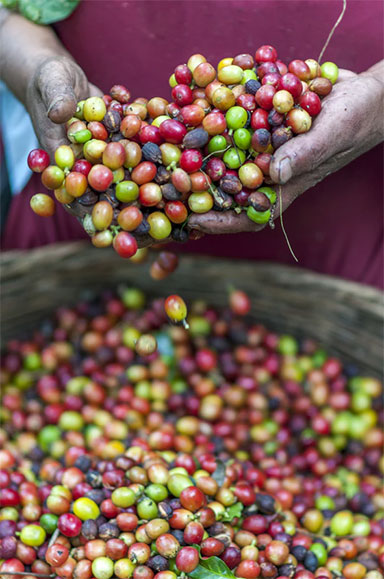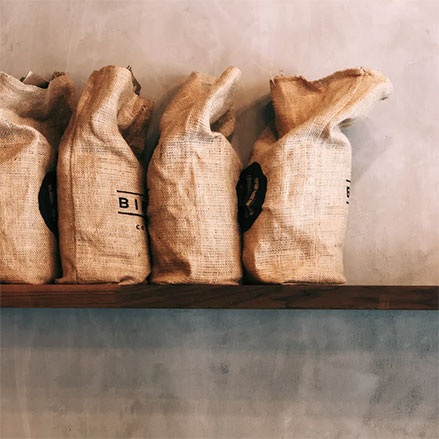Robusta : the bad guy of the coffee family

He is often the pariah of the coffee family, as he is connected with bitter, poor quality coffees, but also with instant coffee, but the truth is different: let's talk about Robusta!
During recent years, there has been an ever-increasing popularity of Arabica coffee. Although Arabica has a more sophisticated flavor profile and a more gentle, delicate flavor, its omnipotence has almost marginalized Robusta, who has acquired a particularly bad name among the coffee lovers. Robusta, however, is an integral part of the evolution of coffee, and it has many qualities, tastes and not only that make it a member of the coffee family - as long as we always talk about quality, properly roasted and packaged beans.
 What is Robusta Coffee?
What is Robusta Coffee?
Robusta is one of the two basic varieties of coffee in the world, along with Arabica. Robusta is produced by the Coffea Canephora plant and accounts for 30-40% of the world's coffee production. It first appeared in sub-Saharan Africa, and today it is widely cultivated in Southeast Asia, with Vietnam being the country with the largest production of Robusta all over the world. It is more resistant to Arabica, it usually yields better crops and its cultivation is easier than Arabica's cousin. It has a higher caffeine content, its flavor is brighter and bitter than Arabica, but at the same time it is richer in antioxidants.
How does Robusta coffe taste like?
Robusta beans produce coffee with full body, intensity and earthy aromas. Both the absence of acidity and the strongest bitterness of Robusta coffee are characteristic, due to its chemical composition. Surely, a Robusta cup lacks flavor complexity compared to a corresponding Arabica, but on the other hand, its flavor is stronger, fuller, more intense.
This is why Robusta is usually used in making espresso blends. Traditional Italian espresso blends typically have Robusta content ranging from 10-15%, reaching 30% or more, depending on the desired properties the blender wants to add to the coffee. Blending is not done for cost reduction purposes (although in general, Robusta grains are considerably cheaper than Arabica grains), but to achieve the necessary balance between Arabica's complex fragrances and the body and aftertaste offered by Robusta.
As for espresso, Robusta offers the blends another characteristic: the crema. Although the espresso cream depends on many factors, it is known that Robusta produces more and more persistent cream than Arabica. Since the right, textured, quantity and duration is one of the attributes that determine the success of an espresso, the presence of Robusta in a blend is often decisive.
Due to these characteristics, Robusta was established as a necessary supplement for espresso blends, and was widely used to produce instant coffee. On the other hand, it is a fact that because of its limited aromatic pallet it has a relatively flat effect compared to a corresponding Arabica when used for filter extraction.
 How did Robusta get a bad name?
How did Robusta get a bad name?
Robusta coffee got its bad name for a number of reasons, not directly related to its basic properties. The most important reason is that being cheaper, more durable and intended to produce instant coffee, Robusta is often grown under conditions that give poor quality beans, while the same poor conditions concern both the bean processing stages and even their packaging. A bad coffee bean is unlikely to give good results to our cup, whether we are talking about Robusta or Arabica coffee. Unfortunately, for many people, Robusta has been identified with moderate quality coffee, and of course there are many quality Robusta coffees in many espresso blends.
Also, for many people, Robusta coffee has been identified with cheap, instant and poor quality coffee, or even with dubious origin blends for Greek coffee. For these reasons we can add the fact that being cheaper, Robusta has occasionally been used as a "supplement", but also the widespread dissemination of the ideas of the "Third Wave of Coffee", which does not seem to particularly love Robusta.
What about present day Robusta?
Everything is done for a delightful cup of coffee - the coffee that we deserve. If we prefer filter brewing, it is best to look for blends made up of 100% Arabica coffees, or even single-origin coffees that highlight the organoleptic characteristics of coffee. But if we love espresso, it is time to leave behind the prejudices and put Robusta in our cup, as long as we are sure we are talking about quality coffee beans that will give the Robusta characteristics the best way.
If you decide to try Robusta coffees, you can start with 70/30 blends, such as Buondi Premium or Lavazza Grande Ristorazione, and if you want an espresso with a strong cream and very strong body, you prefer a blend with reverse ratio, such as Lavazza Gran Espresso, consisting of 70% high quality Robusta grains. Finally, for bolds there are choices with 100% Robusta content, such as the Amigos Qualita Rossa , but also unrivaled choices of really robust Robusta grains such as Cosmai Raja!
Everything is about good coffee, after all!










